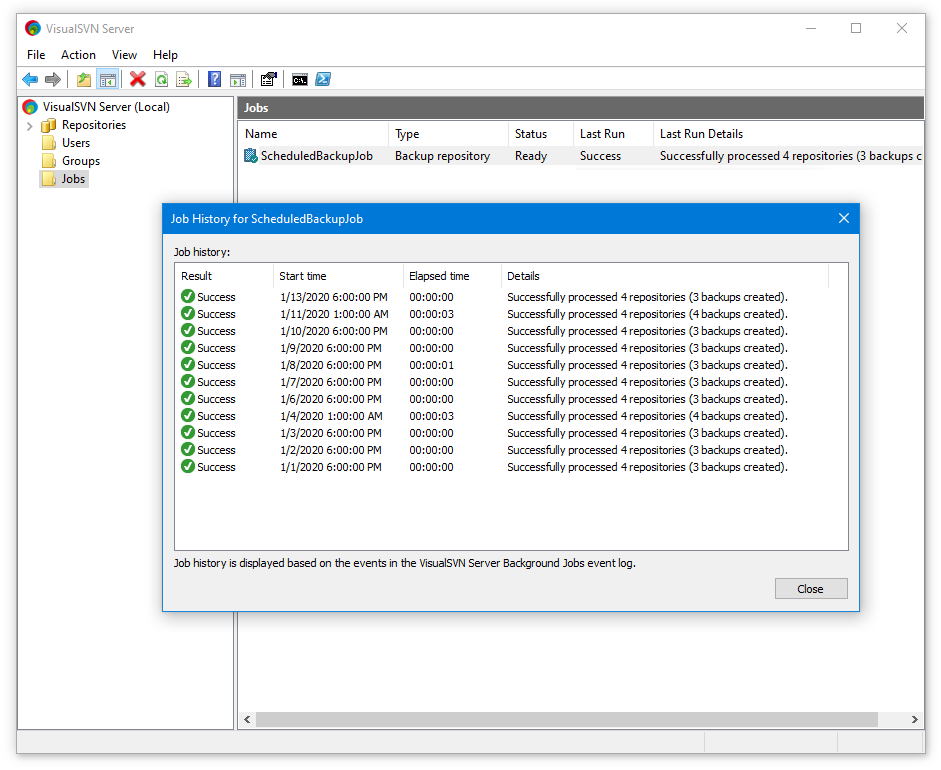

- Visualsvn server logs how to#
- Visualsvn server logs install#
- Visualsvn server logs update#
- Visualsvn server logs free#
- Visualsvn server logs windows#
Now all we have to do is write a proper "hook" script that gets called right after we commit some files.
Visualsvn server logs update#
We're almost done! What we have accomplished so far is that we are able to update Mantis remotely, from the machine running the VisualSVN (or subversion) server. If not, specify -v on the plink commandline to get verbose output. If you've filled in the correct values for the placeholders above plink should return without outputting any warning or error, and a note should be added to the specified issue in Mantis.

The next step is to use Plink, a commandline version of PuTTY that can be used to run commands on a remote server using ssh without dialogs or user input: You should now be able to run the checkin script through PuTTY using the same commands as above. The server should have authenticated you using the key you pointed to in (4). If you imported and authenticated the public key you created in (2) correctly on your server you should NOT have to enter a password. Now enter the username you use for ssh access to your Mantis server (in the case of hostmonster this is your account name). If this is the first time you access this server using PuTTY it will display a warning:Ĭlick yes to store the server's fingerprint in the registry (so you don't have to do this the next time). Path-to/php-cli path-to/checkin.php "username" SSH->Auth->Private key file for authentication
Visualsvn server logs how to#
Now login to your server (through ssh) and run the script as follows (if your host doesn't have a simple way to log in using ssh read on to see how to use PuTTY for this): First create a new test issue in Mantis and note the issue number. To see if Mantis is configured correctly you can test the script. For this to work you need to make sure that the usernames you have configured in VisualSVN (subversion) are the same as the ones you configure in Mantis. Now the script accepts a username as the first parameter to the script. I didn't want to always specify the same user, but instead specify the name of the user actually committing the files. This script originally uses g_source_control_account to specify the name of the user updating the issue. The script can be found in the "scripts" subfolder in your Mantis installation and is called checkin.php. Mantis v1.2.0 comes with a script that you can call from your source control application when committing (or checking in) files.

If you omit this statement all notes will be "Private".

If you fix a bug or implement a feature Mantis will set the issue to status "Resolved".
Visualsvn server logs windows#
Our situation is a bit different, being that Subversion runs on a Windows server and Mantis runs on a Linux server on the other side of the world. ) The solutionĪ lot of information can be found on the net about integrating Subversion and Mantis when they both run on the same Linux server. Robot does not allow implementation of self-destruct command. Robot now enters low power mode when in surveillance mode.įixed bug #65. I want to be able to write comments like: The goal is to automatically update the status and notes of an issue when committing changes to the SVN server through the TortoiseSVN client. Mantis is running on a Linux server on the other side of the world.
Visualsvn server logs install#
Subversion runs on a Windows Server through VisualSVN Server (VisualSVN Server makes the Subversion server easy and convenient to install and administer on Windows).
Visualsvn server logs free#
The current setupĪt GuruCE we use Subversion (aka SVN) for source control and Mantis (a free popular web-based bugtracking system) for tracking bugs & features. This post is a bit off-topic for this blog, but since source control and bugtracking are important for Windows CE development as well I thought I'd post about my experiences for (my own) future reference (but I'm sure this will help others as well).


 0 kommentar(er)
0 kommentar(er)
